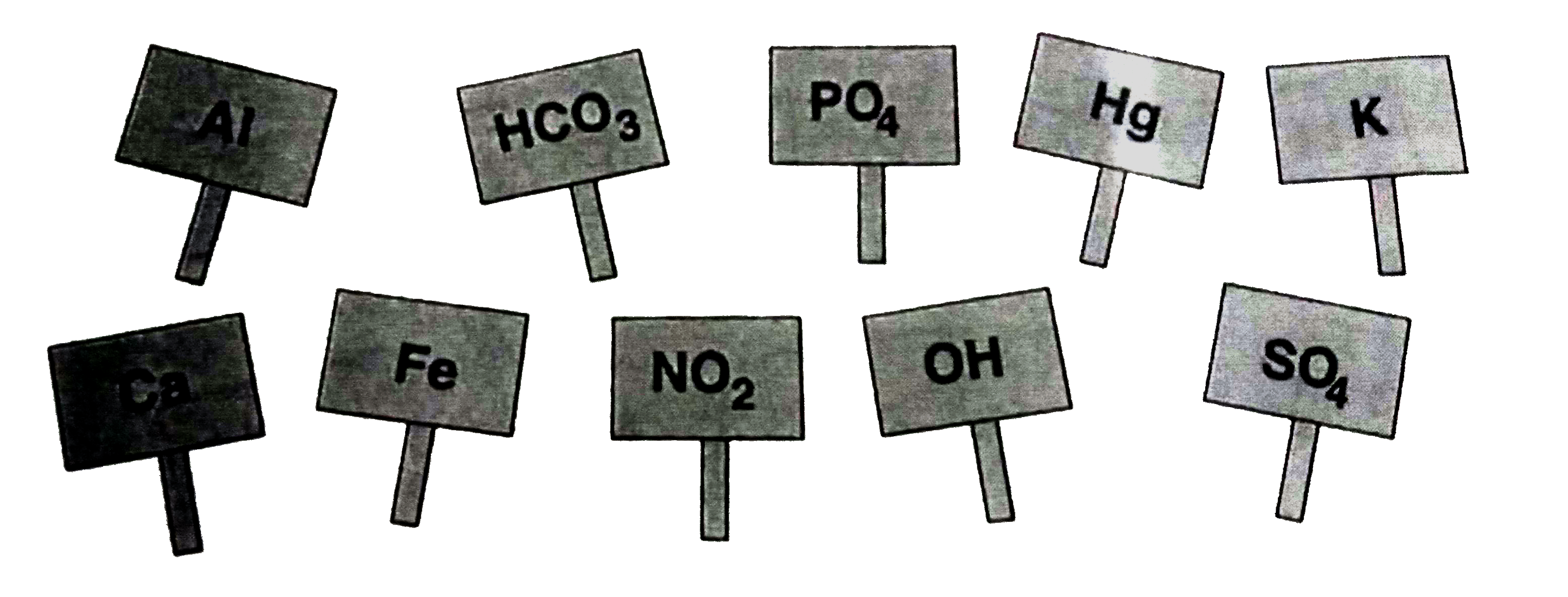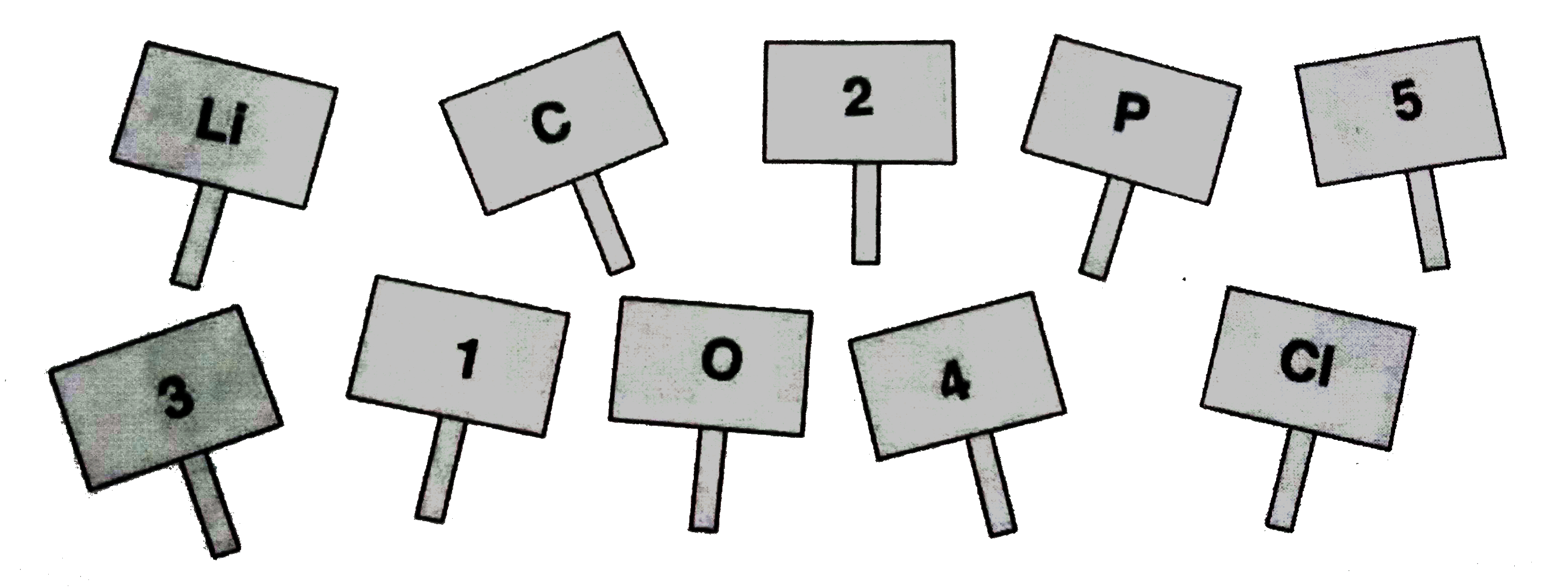Pratap is a student of class IX in a city school. He has recently studied the writting of formulae of ionic compounds in the class. Pratap has made some placards for a science quiz showing the symbols of some elements and some ions but forgot to write the electric charges on the ions. Moreover, the placards made by Pratap got mixed up as shown below :

Based on these placards, the chemistry teacher, Mr. Suri, asked Pratap to answer the following question :
(a) Choose the symbol of the element from among the placards which can form divalent and trivalentcations. Name this element. Also write the symbols of these cations along with their charges
(b) Choose the symbol of a divalent anion from among the given placards. what is the name of this anion. Also write the symbol of this anion alongwith its charge
(c) Work out the formula of the ionic compound formed between the divalent cation and divalent anion described above. Also name the compound formed
(d) Work out the formula of the ionic compound formed between the trivalent cation and divalent anion described above. Also name the compound formed
(e) What values are displayed by Pratap in this episode ?
(a) The positively charged ions are called cation. The symbol of element which can form divalent cations. (valency 2+ ions) and trivalent cations (valency 3+ ions) is Fe. The name of the this element is iron. The symbols of two cations formed by iron element are Fe2+ [ferrous ion or iron (II) ion] and Fe3+ ion [ferric ion or iron (III)ion]
(b) The negatively charged ions are called anions. The symbol of the divalent anion (valency 2-ion) is SO4. The name of this anion is sulphate ion. The symbol of sulphate ion along with its charge is SO2−4
(c) The divalent cation (or valency 2+ ion) is Fe2+ and the divalent anion (valency 2- ion) is SO2−4. The formula of compound formed from these ions can be worked out as follows :

Thus, the formula of compound formed is FeSO4. It is ferrous sulphate or iron (II) sulphate
(d) The trivalent cation (or valency 3+ ion) is Fe+ and the divalent anion (or valency 2- ion) is SO2−4. The formula of compound formed from these ions can be worked out as follows :

Thus, the formula of compound formed is Fe2(SO4)3. It is ferric sulphate or iron (III) sulphate
(e) The values displayed by Pratap in this episode are (i) Knowledge of cations (positive ions) and anions (negative ions), and their valencies, and (ii) Ability to use this knowledge in solving problems.
Topper's Solved these Questions
Similar Questions
The students of class IX have made placards showing the symbols of some elements and valencies of these elements. These placards somehow got mixed up as shown below :

On this basis of these placards the chemistry teacher, Mrs. Shanti, asked a student Vikas to answer the following questions :
(a) Choose the symbol of an element from among the placards which exhibits valencies of 3 and 5. What is the name of is the name of this element ? Is it a metal or a non-metal ?
(b) Choose the symbol of an element from the given placards which shows a valency of 2. What is the name of this element ? Is it a metal or a non-metal ?
(c) Work out the formula of the compound formed between the element of valency 3 and element of valency 2. Also name this compound
(d) What values are displayed by Vikas in this episode ?View SolutionA ionic compound has a unit cell consisting of a ions at the corners of a cube, B ions on the centres of the faces of the cube but one axis of its faces are missing. The empirical formula for this compound would be -
View Solution
Knowledge Check
- Question 1 - Select One
The ionic compound is made up of
Aneutrel atomsBneutral moleculesCelectrically charged atoms or group of atomsDelectrically charged molecules - Question 2 - Select One
Rana Pratap Sagar is located in
AUttar PradeshBHaryanaCMaharashtraDRajasthan - Question 3 - Select One
An ionic compound has a unit cell consisting of A ions at the corners of a cube and B ions on the centres of the faces of the cube. The empitical formula of this compound would be
AAB3BA3BCABDA2B
An ionic compound has a unit cell consisting of A ions at the corners of a cube and B ions on the centers of the faces of the cube .The empirical formula for this compound would be
View SolutionAn ionic compound has a unit cell consisting of A ions at the corners of a cube and B ions on the centers of the faces of the cube .The empirical formula for this compound would be
View SolutionAn ionic compound has a unit cell consisting of A ions at the corners of a cube and B ions on the centers of the faces of the cube .The empirical formula for this compound would be
View SolutionThe unit cell of a compound made up of the three elements X, Y and Z is given below.
 The formula of this compound isView Solution
The formula of this compound isView SolutionThe compounds containing ionic bonds are known as ionic compounds. They are formed by the transfer of electrons from one atom to another. The ionic compounds are made up of positively charged ions (cations) and negatively charged ions (anions).
Ionic compounds are made up ofView Solution

